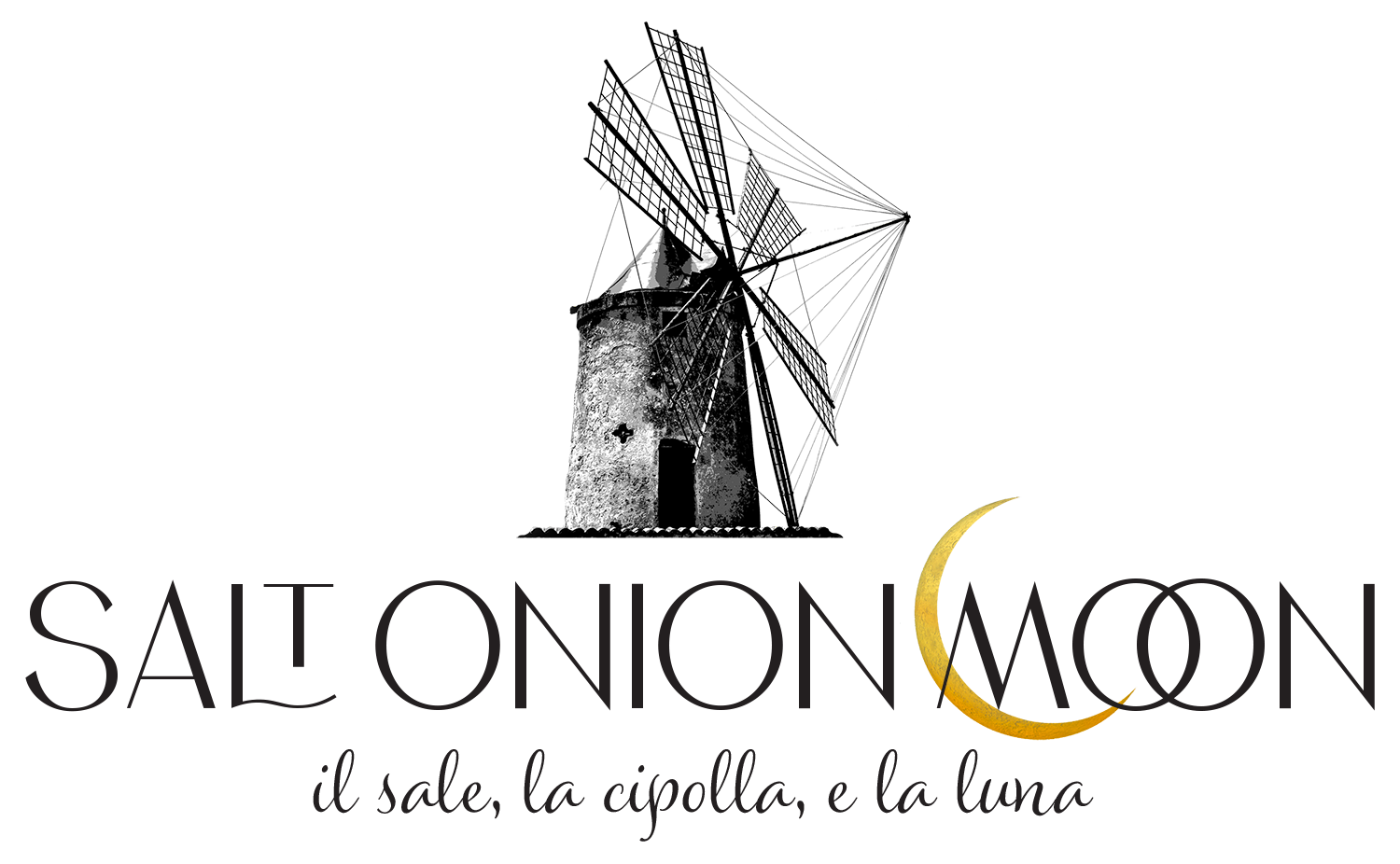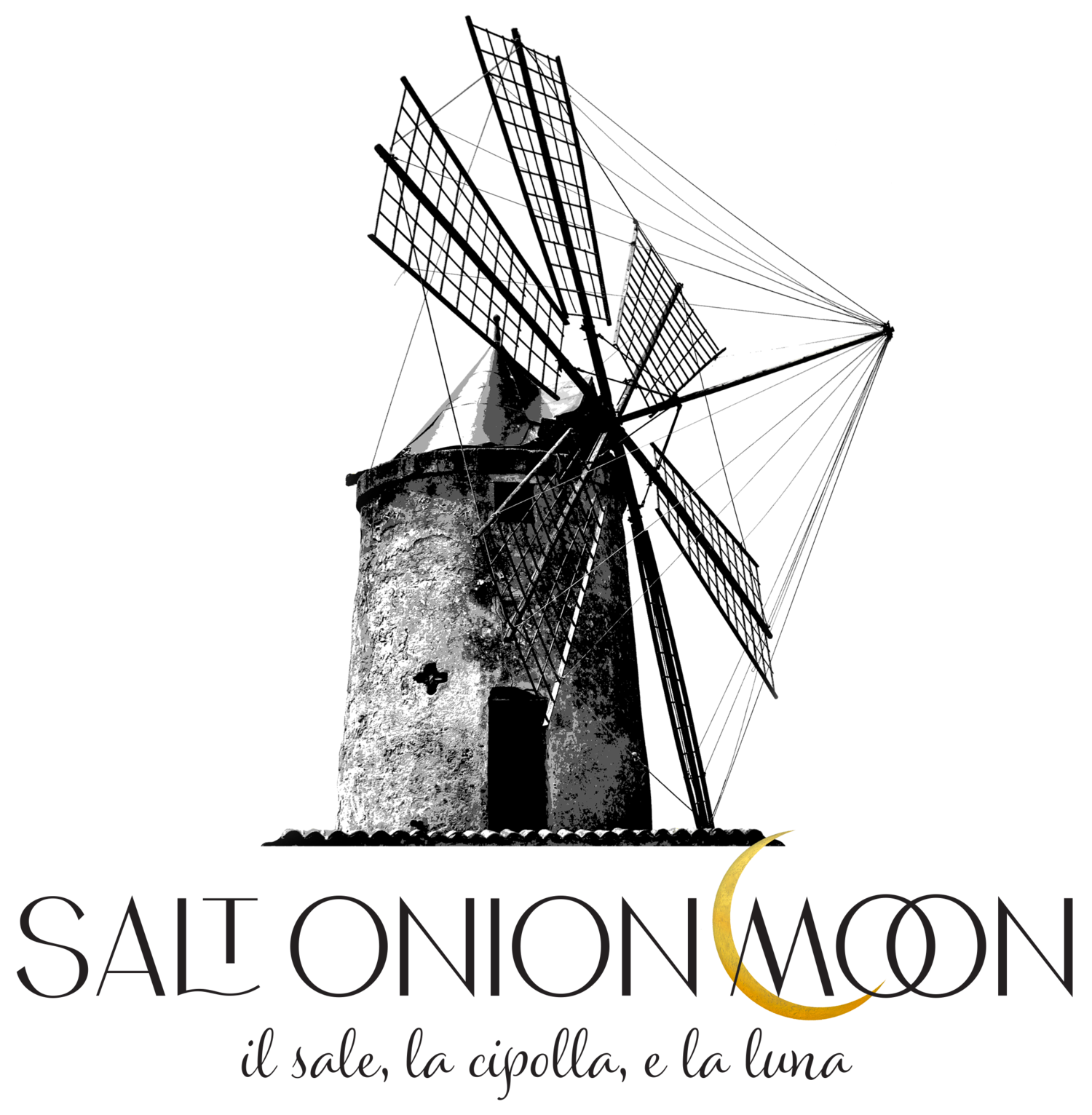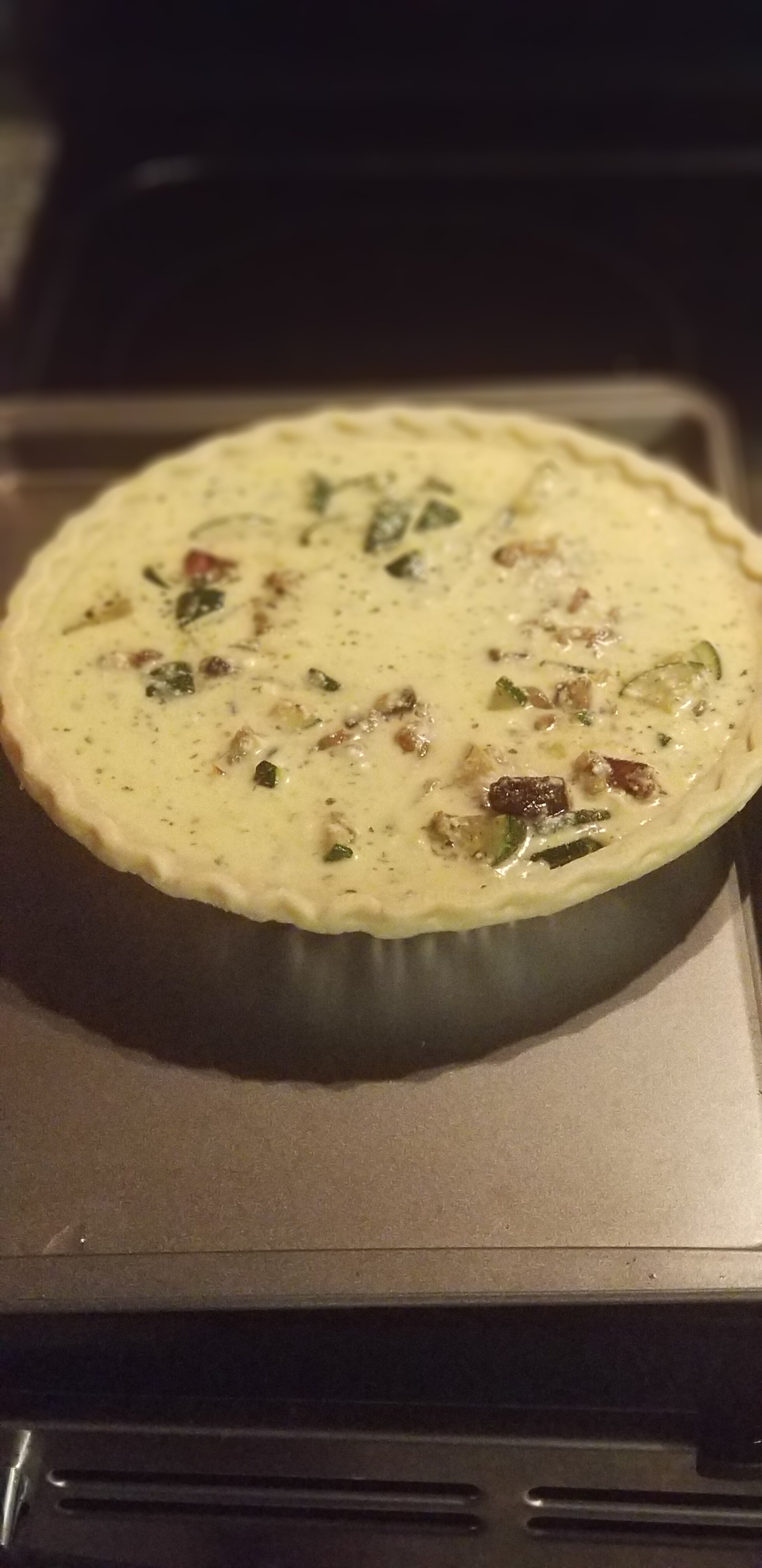A Tale of Two Quiches
This Coronavirus pandemic caused a wonderfully strange and delicious response to home quarantine. People are cooking at home for almost every meal. One of the fun by-products of all this home cooking is dealing with the leftovers. Those extra bits of meat, vegetables and cheese that you have are just languishing in your fridge could turn into something scrumptious with a minimal amount of time out of your day.
Today was one of those days. I decided to clean my fridge. Because I cook a lot, I have many little stashes of yum-yums that I know I must use up or lose completely. Well, waste not; want not. I went on a scavenger hunt. I grabbed a bowl and started filling it like Rachel Ray when she’s collecting ingredients for a recipe. What did I find? Heaven…
I see you, you little buggers… I had to pull everything out, but I see you!
Guanciale, porcini, fresh thyme, garlic, parmigiano, pecorino, Neufchâtel, sour cream, eggs, onions, zucchini, portobello mushrooms, Half & Half, Irish swiss cheese…well, that’s a frittata. But WAIT! Last week I was in my neighborhood Aldi and saw frozen pie crusts were on sale at a buck a piece. I bought two. Those sneaky little crusts were literally hiding in the back of my freezer, but I found them. Mission Control, we have quiche!
Quiche is a great way to move products out of your fridge that are about to end up in your trash bin. Pasta or omelettes are, too. But I was feeling nostalgic today for the 80s and the little quiche revolution that happened here in the US. And despite what satirist Bill Feirstein quipped in his book title, the two men in this house really do eat quiche!
This is a tale of two quiches.
The idea is to make two quiches using similar base ingredients and switching out the main flavor profile. You really can’t go wrong if you stick to areas of the world and their particular flavors. Italy, Spain and France are always good bets but you could also think Deep South USA, Mexico, Maine, Vermont, India… etc. I had loads of portobello mushrooms, Italian bacon and zucchini so my flavors were set by that.
In one of Kim’s posts called Zucchini Squares, she uses a combination of flavors that I happen to love. Oregano, Parmigiano, Onion, and Zucchini. That settled the flavor of my first quiche.
The smoke point for olive oil is 400°F/205°C while the smoke point for lard or pork fat is approximately 374°F/189°C. A little olive oil will slow that smoking point down a little so there is no fire! This is also why savvy cooks add a tablespoon of olive oil to the butter melting in their sauté pan. Butter’s smoke point is 302°F/150°C, by adding olive oil with a smoke point of 400°F/205°C we can help ensure that we don’t burn the butter. It’s just a little more control you can exert.
The other quiche had to be mushroom since I had so many of them. I decided to change the cheese to a nutty Swiss like in Quiche Lorraine, which is traditionally Swiss or Gruyère and bacon. But instead of bacon, I had this beautiful chunk of Guanciale waiting for me in my deli drawer. Guanciale is a cured Italian pork product made from the pig’s cheek or jowl. In Italian, the word guancia means cheek. It is usually cured with salt, sugar, spices like red or black pepper, and herbs like thyme or fennel. It has a bit more flavor than pancetta or bacon. It is cured with salt, but not salty like American bacon. It is a wonderful product and comes from the Italian charcuterie tradition of using the entirety of the very noble pig. It is most easily found in central Italy in Tuscany and Umbria, though I found it at a really cool store here in Tampa called Cacciatore Brothers. It’s an amazing place with everything you need to make authentic Italian food. (They have two locations. The one on Hanley is larger and has more products. I’d start there.)
First, I sliced the guanciale into lardons about 1” x 1/2”. I tossed the pieces into a cold, non-stick skillet with a splash of olive oil just to make sure it cooked a little slower and I could control the browning over higher heat. (see note above right) Then I pulled the lardons out and sautéed 2 large onions in that same pan with a nice big sprig of fresh thyme. This will be the base for both quiches so I put them aside.
Next, in that same pan, I sautéed some garlic in butter and a good splash of olive oil. I tossed in the zucchini and about a tablespoon of dried Italian oregano. After the zucchini started to brown, I added a squeeze of lemon to deglaze the bottom of the pan and turned it all out onto a cutting board to cool down..
Next, also in that same pan, I sautéed my Portobello mushrooms with butter, a splash of olive oil, a couple of teaspoons of minced garlic and a spring of fresh thyme. I combined them with the dried porcini mushrooms which I reconstituted in boiling water, chopped and incorporated into my mushroom sauté.
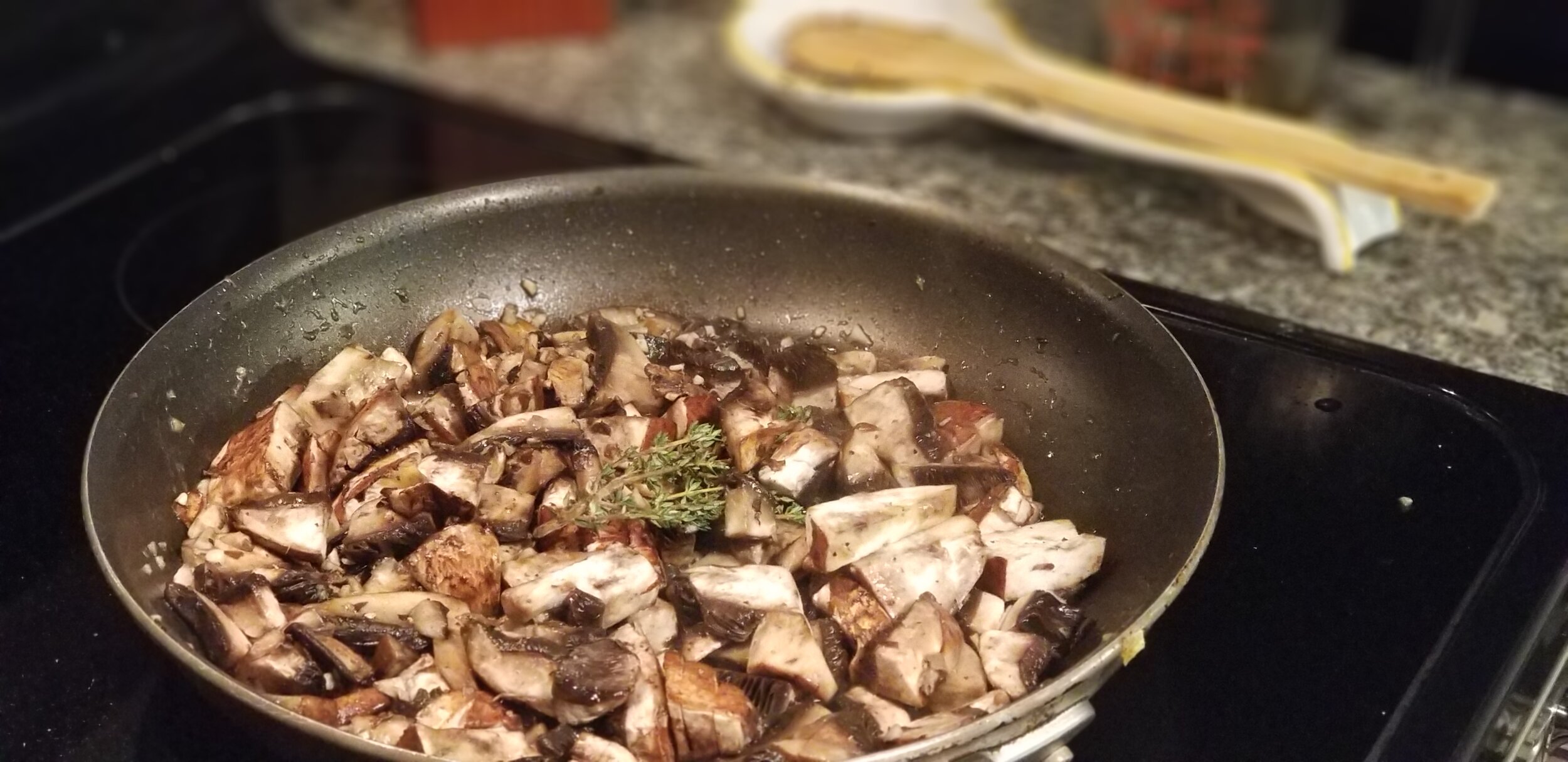
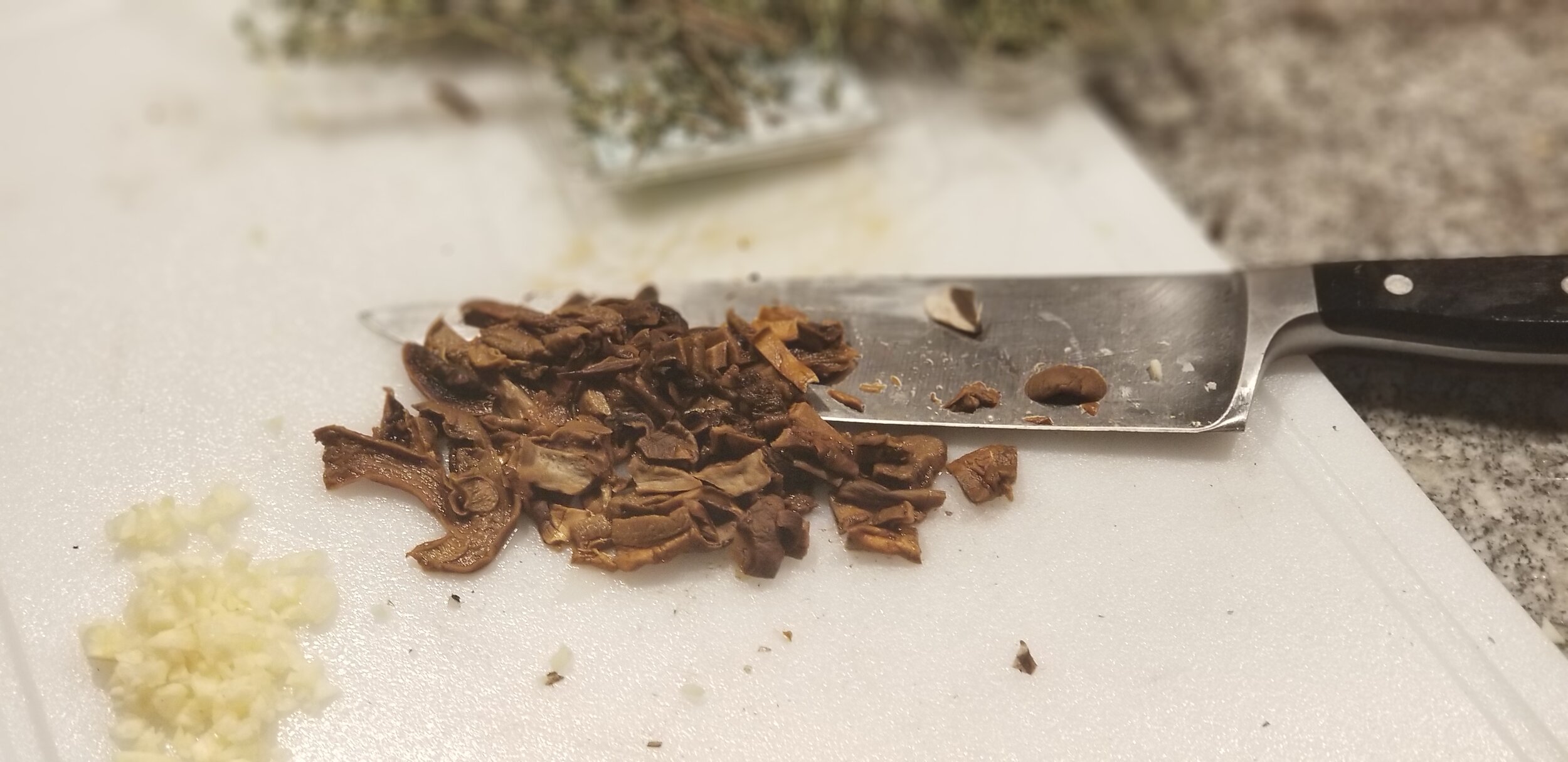
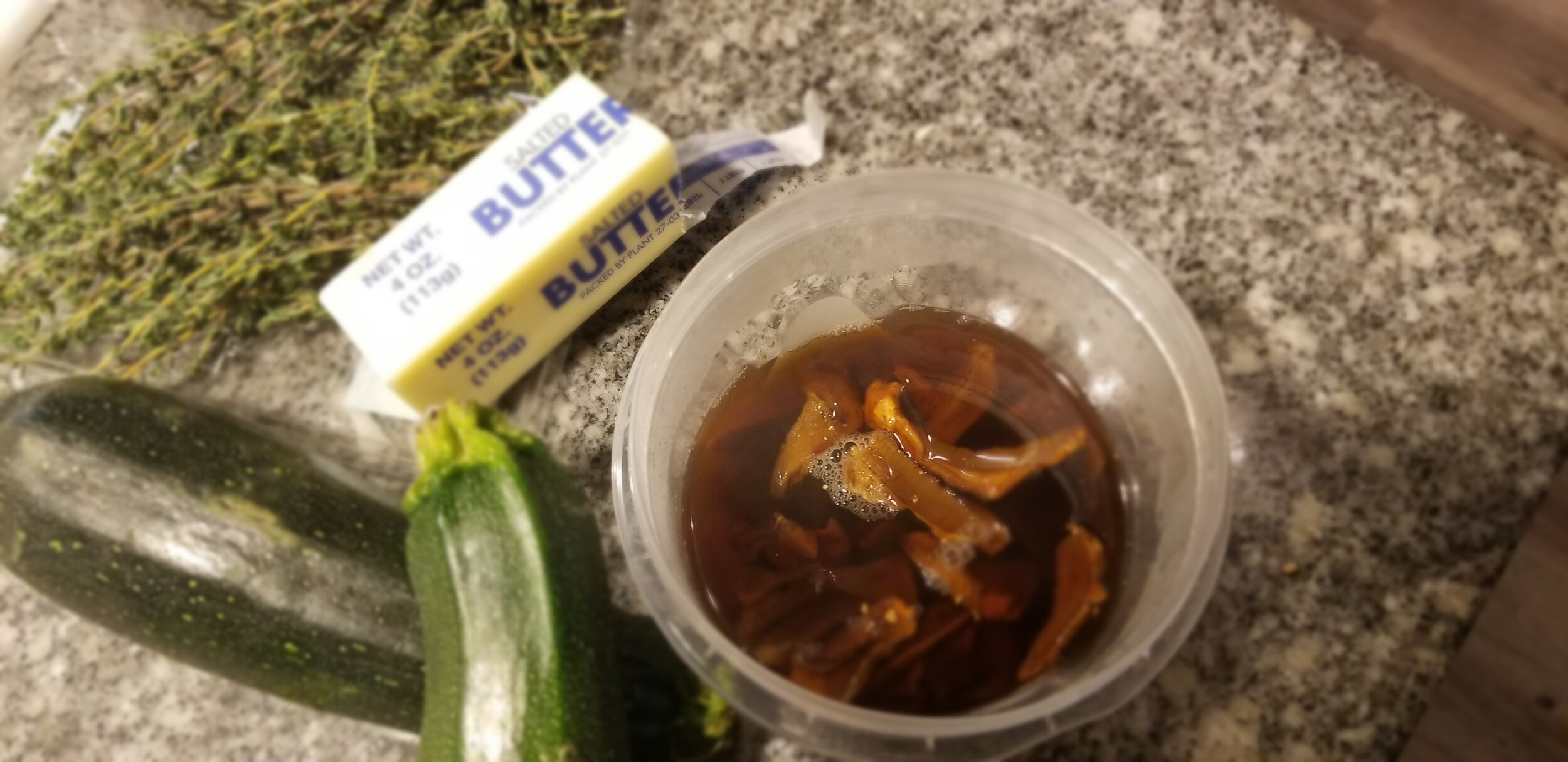
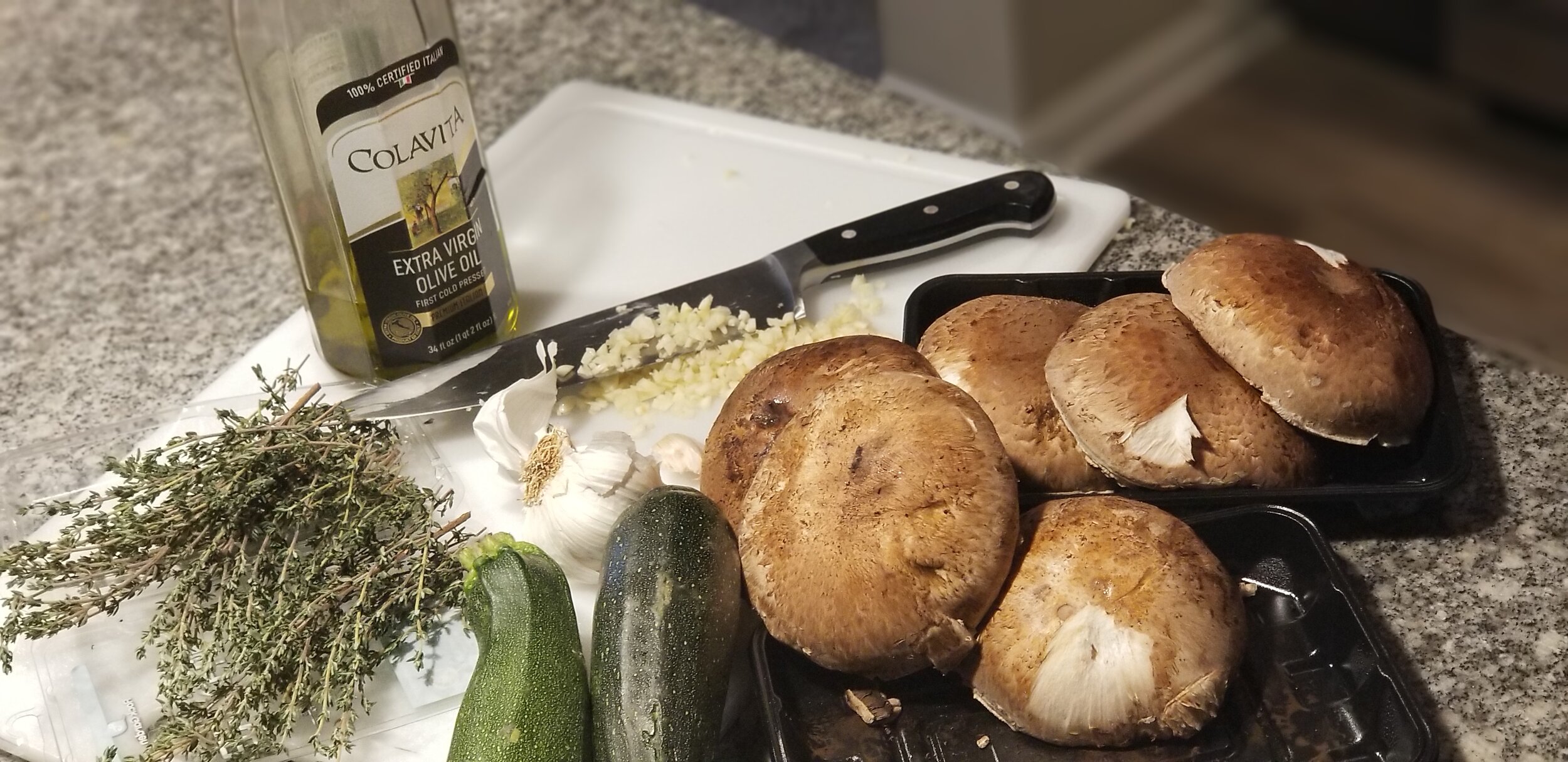
With the main ingredients of my two quiches ready, I now I needed to beat my liquids together while the other three sautés just cooled a bit. You do not want to introduce hot ingredients to your custard filling.
The recipe I used as a guide was from the King Arthur Flour website called Mushroom-Cheddar Quiche. There is also a lovely recipe for a homemade pie crust there, but I had two frozen ones that always taste great so I used them. It calls for 8 eggs and ½ cup of heavy cream, 1 cup shredded sharp cheddar cheese and an easy mushroom and onion sauté with 1 teaspoon dried thyme or 1 tablespoon fresh, ½ teaspoon salt, and ¼ teaspoon ground black pepper.
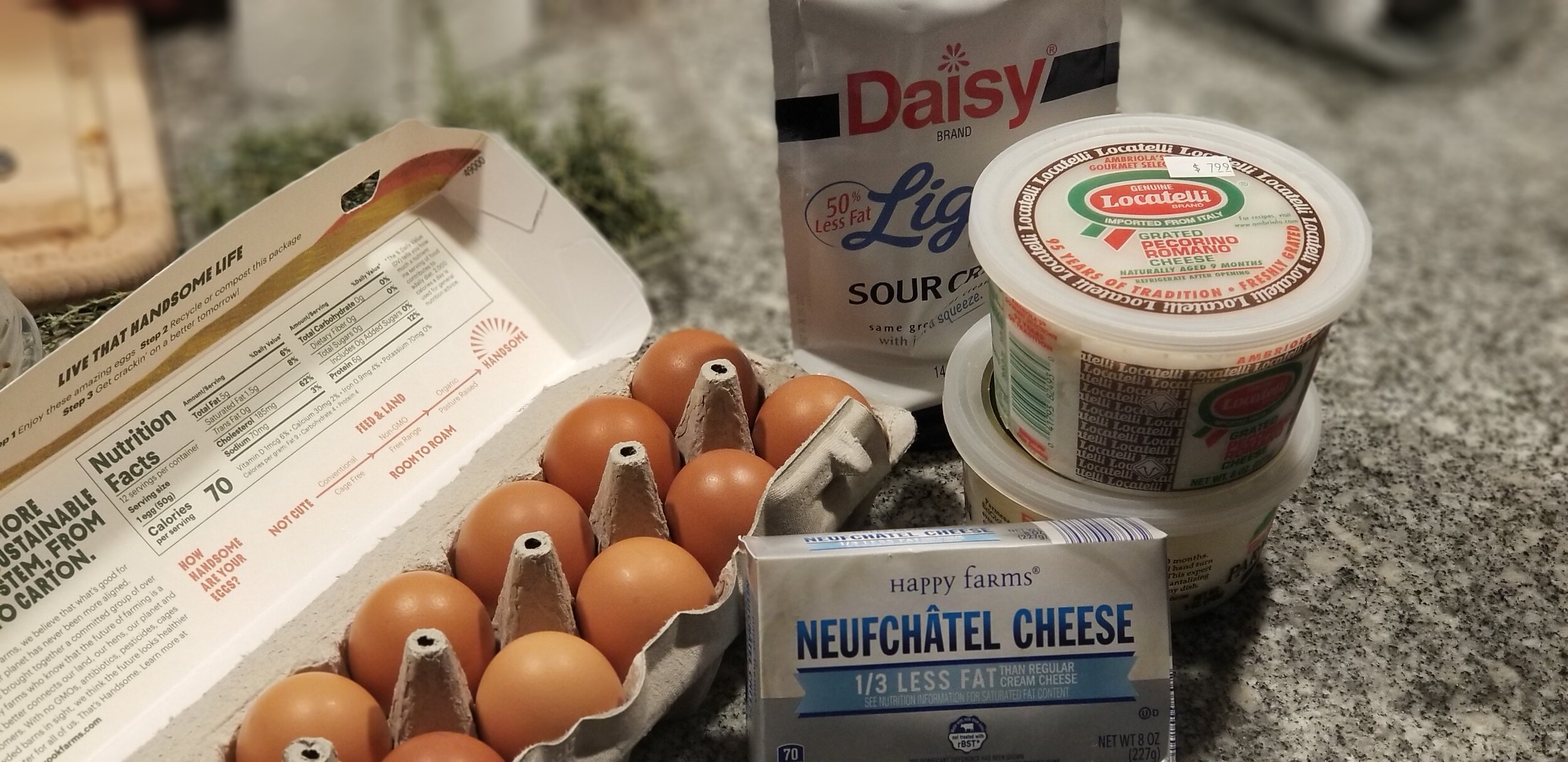
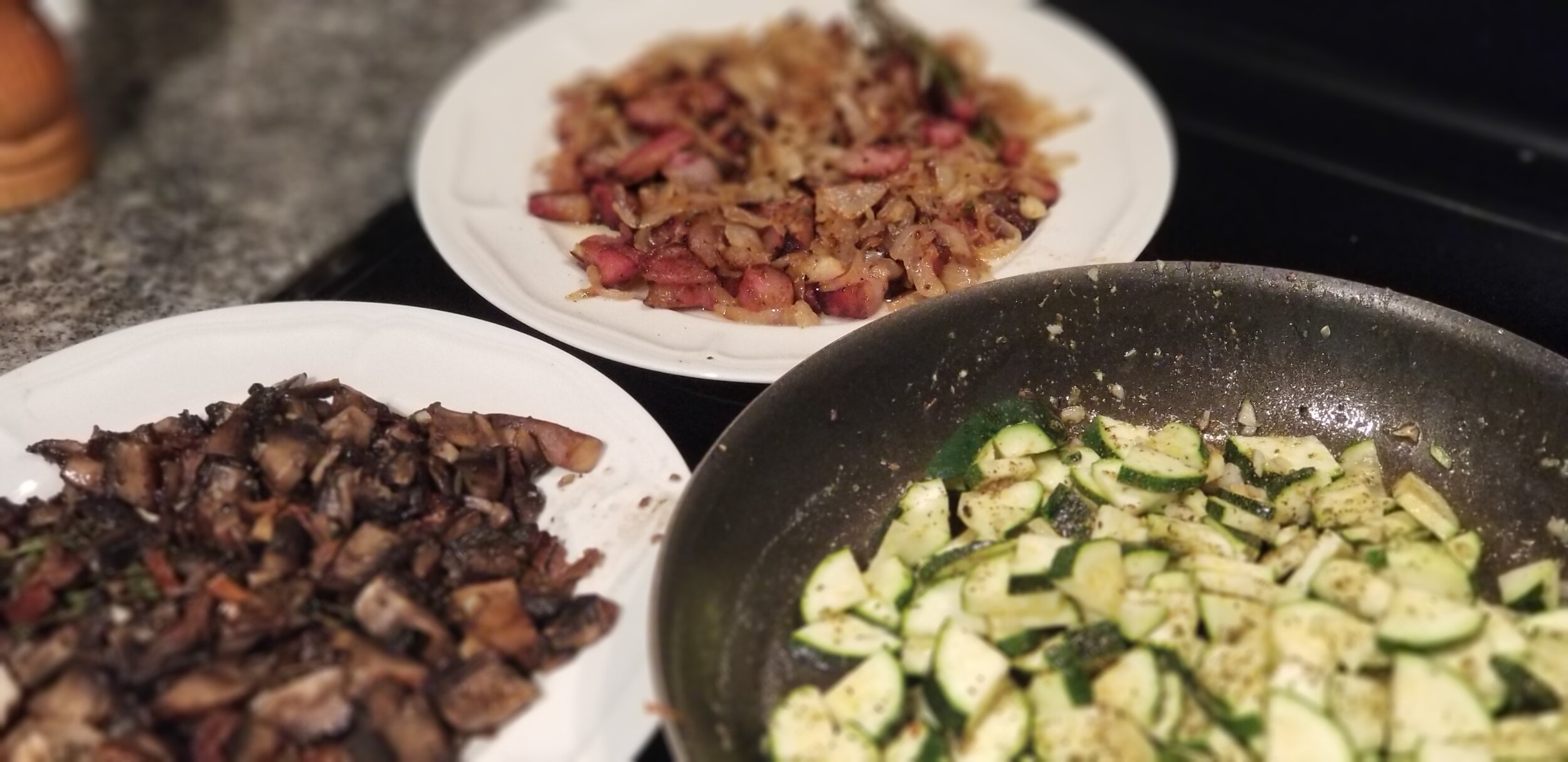
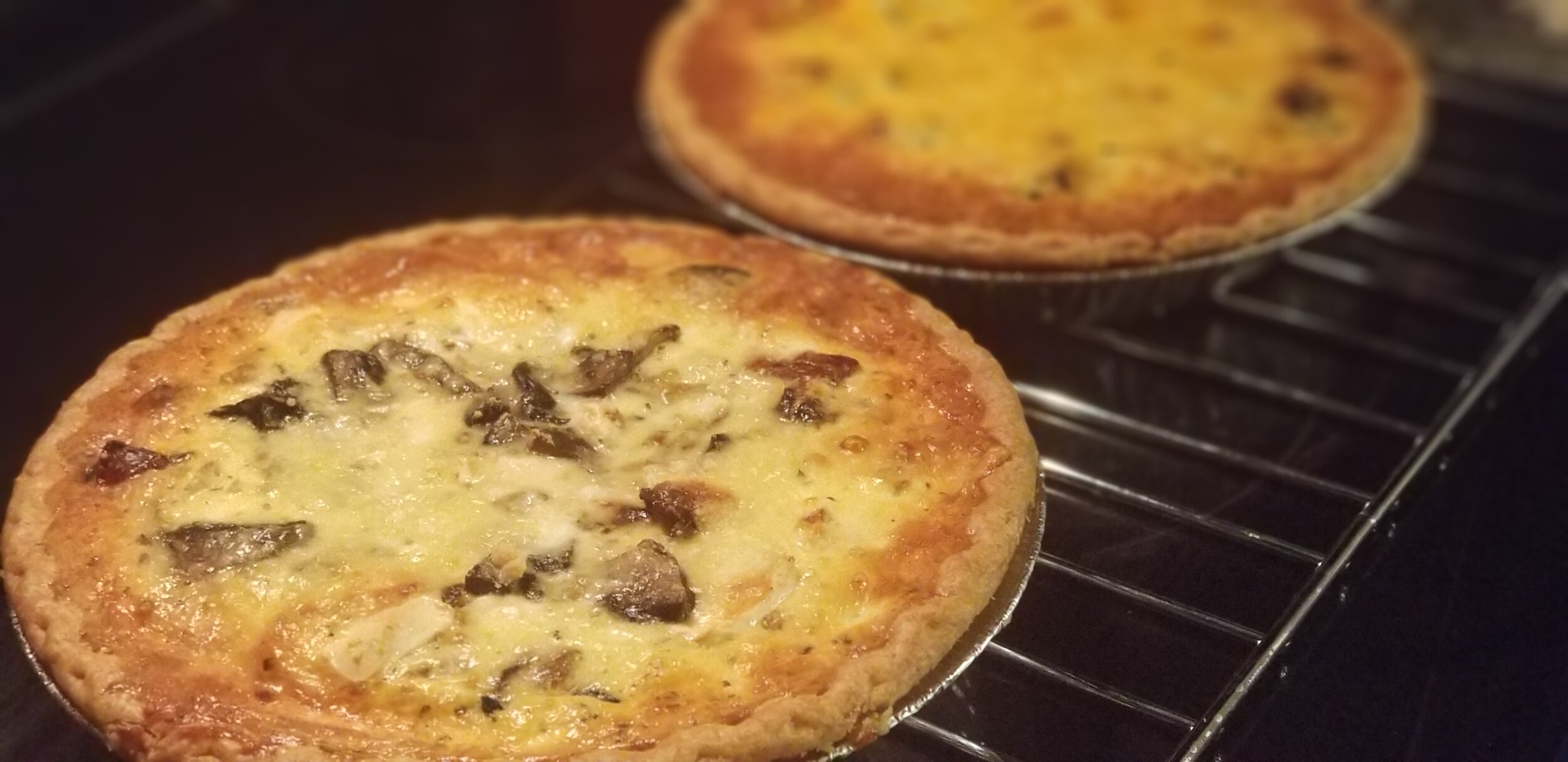
What you must know is you can easily tweak the custard aspect of any quiche as long as you keep the proportions the same or only slightly enhanced. Divide the cheese up anyway you want, using more or less of your favorites. Change the herbs up. If there is meat, try to keep the portion the same but change it up as you like. For instance, if it calls for four slices of bacon, use four slices of ham or four breakfast sized chicken sausages. If you use slightly more it’s not going to alter the product. Just make sure you err on the side of restraint. Once I used too many mushrooms and they became a bit watery. The point is, a quiche is a wonderful opportunity to express yourself.
I always feel as though part of my mission with food is to give people a few tools to be able to express themselves in creative ways. Once you feel comfortable with flavor profiles and proportions on whatever the recipe is that you’re working on, your own personal variations can give the dish your own imprint and fresher outlook.
I spent hours one day trying to re-work the traditional Clafoutis recipe to create a savory, quiche-like pie. It did not like being messed with. But that’s another post. Sometimes it’s a delicate matter because certain recipes are persnickety and well balanced and do not like change. Quiches are not at all persnickety. They are actually rather malleable and fun to work with. If you are slightest bit intrepid, you will be rewarded with a sense of satisfaction when the dish you have made is a real expression of what you were trying to create. Maybe it’ll also save you a trip to the grocery and the risk of Coronavirus exposure.
Here’s a version of my quiche broken down so you can fill in the blanks with your own flavors. Choose wisely. Think internationally with your flavor profiles and you will be rewarded with homecooked yumminess.
Buon Appetito a Tutti!
Fantasia on a Traditional Quiche
8 large eggs
9” pie crust frozen or homemade
1/2 cup of heavy cream
1 tablespoon of sour cream
1 cup of cubed, melty cheese or split it 1/2 cup and 1/2 cup and choose two or into thirds or even quarters. Combinations of cheese always give a deep flavor profile. I love quarters or stilton, gruyere, parrano and cream cheese. Just play with it!
1/4 cup of sharper grated cheese like parmesan cheese saving several pinches for the top
1/2 cup of any vegetable that you like grilled, blanched or sauteed
1/4 of a cup of any kind of cooked meat that you like
1/4 teaspoon of freshly grated nutmeg
1/4 teaspoon salt - adjustable if your cheeses are saltier
1/4 teaspoon of fresh cracked pepper
2 teaspoons of your favorite herb- thyme, tarragon, oregano, marjoram, chervil, basil, fennel all work well depending on where you want to lead the flavors of your quiche.
Preheat the oven to 375°F. Take a fork and poke some holes in the bottom of your pie crust for more complete baking. Beat eggs with sour cream, grated cheese, salt, pepper, herbs, and nutmeg. Set aside. Place frozen pie shell on a cookie sheet. Nicely place an arrangement of the meat, vegetables and cubed cheese into the bottom of the 9” pie pan. Pour egg custard mixture over the meat, cheese and vegetables. Cook 30-35 minutes or until the enter is 160°F on your instant read thermometer.
Let stand for about 10 minutes before cutting.
